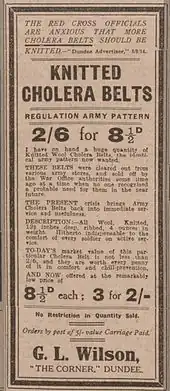Cholera belt

A cholera belt was a flat strip of (usually red) flannel or knitted wool about six feet long and six inches wide which was twisted around the abdomen before wearing a shirt and purported to be a preventive measure against cholera. It was a standard army issue and widely believed to protect the wearer from cholera, dysentery and other ills thought to be brought about by chilling of the abdomen. Their use continued well after the causal agent of cholera was established.[1] In 1848 the instructions to army medical officers in India included the suggestion that every soldier should be provided two "cholera belts". In the early 1900s, its use was still recommended for preventing dysentery.[1] In 1914, donations by the tiny village of Middlemarch, New Zealand of items such as tobacco, shirts and tinned fruit for soldiers going to fight in World War I, included "26 cholera belts".[2] The idea of abdominal chilling as a factor in illness was brought up as late as 1947[3] although it was rejoined by those who pointed out that the idea was not based on experimental evidence.[4]
References
- 1 2 Renbourn, E.T. (1957). "The history of the flannel binder and cholera belt". Medical History. 1 (3): 211–225. doi:10.1017/S0025727300021281. PMC 1034286. PMID 13440256.
- ↑ Cited on p. 4, Taieri Pet, Newsletter for Middlemarch area, 1 August 1914
- ↑ Kershaw, G.R. (1947). "Acute non-specific diarrhoea and dysentery. Local chilling of the abdomen as a causative factor". British Medical Journal. 1 (4507): 717–719. doi:10.1136/bmj.1.4507.717. PMC 2053389. PMID 20248097.
- ↑ Smith, G.L.Morgan (1947). "Correspondence. Acute non-specific diarrhoea and dysentery". British Medical Journal. 2 (4517): 189. doi:10.1136/bmj.2.4517.189-a. PMC 2055274. PMID 20255535.